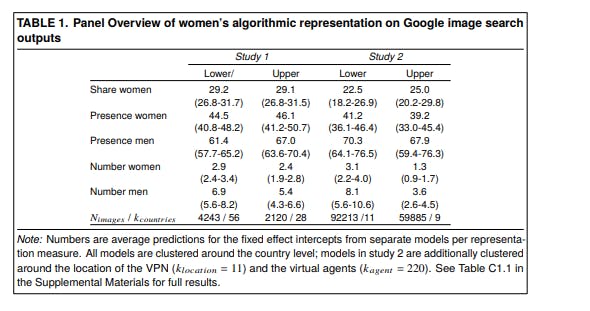Table of links
ABSTRACT
[INTRODUCTION]()
SEARCH ENGINES AND WOMEN’S DESCRIPTIVE REPRESENTATION
MEASURING THE EXTENT OF ALGORITHMIC REPRESENTATION
GENERAL DISCUSSION, CONCLUSION AND REFERENCES
SEARCH ENGINES AND WOMEN’S DESCRIPTIVE REPRESENTATION
Collective descriptive representation is the quality of political institutions to represent their citizens on the basis of shared political and sociodemographic characteristics (Atkeson and Carrillo 2007; Bratton and Ray 2002). Increases in descriptive representation of minoritized groups have been connected to policy outcomes that benefit their substantive interests, thus decreasing structural inequalities (Bratton and Ray 2002; Hessami and da Fonseca 2020; Lowande et al. 2019; Wängnerud 2009; Mendelberg et al. 2014). The inclusion of women in governing bodies also has a symbolic quality (Stokes-Brown and Dolan 2010). Whether governments adequately approximate the demographic composition of their population “sends important signals about who should (and should not) participate in politics and the degree to which certain groups and interests will receive a fair hearing” (Stauffer 2021, 1226). Descriptive representation gives rise to a range of political perceptions, such as impressions of who is qualified to be a political leader and more symbolic ways of feeling (un)fairly represented (Atkeson and Carrillo 2007). At its very core, descriptive representation therefore acts as a visibility mechanism that highlights political perspectives with which citizens can identify (Dolan 1998).
Scholars have identified media discourse as an important factor shaping how citizens see themselves and whether they perceive their interests as represented (Kahn 1994). The prevailing conclusion of this line of work is that political coverage under- and misrepresents minoritized groups (Gershon 2013; Van Der Pas and Aaldering 2020) and that these distortions in coverage result in diminished evaluations of political candidates belonging to these groups (Rohrbach et al. 2023; van Oosten et al. 2024). In this article, we tackle this much needed update of this line of reasoning and propose a framework of algorithmic representation. The core argument of the framework is that political inequalities are built into search algorithms whose output then reinforces political perceptions that cement disadvantages in the political landscape (for a similar argument see Vlasceanu and Amodio 2022). In the following, we formulate our framework as a set of four types of bias driving the extent of algorithmic representation and its consequences for political perceptions.
Algorithmic representation as outcome of structural inequalities
Most people never encounter politicians in person but through intermediaries, such as media coverage (Shehata and Strömbäck 2014; Kahn 1994). The gendered mediation thesis posits that the transformation of a political reality into a mediated reality happens through various journalistic filters (Gidengil and Everitt 2000; Trimble et al. 2022). These filters take the form of gendered organizational structures of newsrooms, journalists’ sourcing and writing practices and their professional norms (Riedl et al. 2022). This filtered mediation presents audiences with coverage that quantitatively and qualitatively upholds a masculinized (and white) view of politics. These views matter as they mark the core of gendered political socialization (Bos et al. 2022; Dassonneville and McAllister 2018) and ultimately shape women’s political ambition to emerge as candidates (Fox and Lawless 2011; Kanthak and Woon 2015).
Today, indirect encounters with political figures increasingly take place in AI-curated digital spaces. AI powered search engines—but also social media feeds and news recommender systems—structure what accounts of politics voters get to see (and which they do not; see e.g. Wallace 2018; Friesen et al. 2021). In “post-broadcast democracies”, the human gatekeeping influence of journalists is increasingly substituted for AI gatekeeping (see Stier et al. 2022). Studies show that search engines like Google have become key sources of political information (Trevisan et al. 2018; Urman and Makhortykh 2023). Moreover, in some cases, people place more trust in the information obtained through their internet searches than in traditional news media (see, e.g., Edelman Trust Institute 2024). The widespread use and perceived trustworthiness of search engines are cause for concern, as research has documented that such algorithmic systems can be biased in political contexts (Epstein and Robertson 2015; Trielli and Diakopoulos 2022). A number of studies have specifically documented the “representational harm” (Fabris et al. 2020, 5) arising from search engines’ tendency to underrepresent women (Pradel 2021; Vlasceanu and Amodio 2022) as well as people of color (Noble 2018; Makhortykh et al. 2021). Applying the filtering logic of the gendered mediation thesis to search engines, we thus expect that political searches on Google have a built-in bias against women (H1):
H1: Baseline bias: Women are algorithmically underrepresented in (gender-neutral) political Google image search outputs
If the masculinized political and social reality translates into an algorithmic underrepresentation of women on Google, then the extent of this underrepresentation should vary across societies with different political benchmarks regarding women’s descriptive representation.4 Borrowing from social role theory, Niven (1998, 2004) explains women’s under-/misrepresentation in political media coverage as a function of the paucity of women leadership roles. This view is in line with dynamic stereotype models which emphasize that stereotypes are shaped by distributions of women and men among distinct occupational roles—that is, in politics, their presence in office (Diekman et al. 2004; Eagly et al. 2020; van der Pas et al. 2023). Not unlike humans, search engine algorithms should be able to observe the distribution of women and men into occupational roles by more frequently encountering and indexing content showing women politicians in countries with higher descriptive representation. Yet due to the inherent baseline bias in their performance (see H1), we expect search engine algorithms to imperfectly mirror gendered role distributions by underrepresenting women relative to their descriptive representation (H2).
H2: Distribution bias: Women’s algorithmic underrepresentation is positively correlated with their descriptive representation across countries but does not exceed it.
Algorithmic representation as a driver of political perceptions
So far we have established the hypotheses that women are likely to be algorithmically rendered less visible than men in the output of political Google searches across national contexts. Drawing on 3For the first two hypotheses, we focus exclusively on gender and disregard the question and disregard race for two reasons. First, measuring the share of non-white politicians in Google output would require labeling the race of depicted persons on a purely visual basis. In addition to strong ethical concerns, computational labeling approaches rely on face recognition algorithms which are themselves subject to inherent race biases (Cavazos et al. 2021; Scheuerman et al. 2019). Second, governments do not typically provide information about the racial or ethnic background of their legislative branches, making it impossible to establish a benchmark for comparison. Note that this argument differentiates between countries with a history of strong inclusion of women and countries with policy-induced gender parity due to gender quotas. strategic discrimination literature, we now outline the consequences of algorithmic representation as two causally linked biases influencing political perceptions. Bateson’s (2020) theory of strategic discrimination describes the tendency of voters to withhold electoral support for minority candidates not on the basis of their own direct prejudice but out of a strategic calculus of these candidates’ perceived ability to win the election (see also Ashworth et al. 2024). While direct race or gender bias in the electorate may be declining (Juenke and Shah 2016; Schwarz and Coppock 2022; Teele et al. 2018), studies on strategic discrimination have consistently found that participants perceive women and Black candidates as less electable and, consequently, are less likely to vote for them (Bateson 2020; Corbett et al. 2022; Green et al. 2022).
We theorize that algorithmic representation operates within the mechanism of strategic discrimination in two steps. First, the representation of minoritized groups in search engine outputs distorts individual perceptions of descriptive representation of those groups (H3). We thus posit that search engine output serves as a political heuristic feeding the gendered perception gap (Lau and Redlawsk 2001; McDermott 1997), which is the “systematic overestimation by men and underestimation by women of their electability” (Ashworth et al. 2024, 290).As most voters have no clear idea of the actual demographic composition of political institutions (see, e.g., Stauffer 2021), search engine users will approximate the algorithmically curated reality with the political reality. Such misperceptions matter, as “public opinion on descriptive representation is likely to explain political behavior at both the individual and systemic levels” (Dolan and Sanbonmatsu 2009, 410; Dolan and Hansen 2018). This suggests a circular logic in which political inequalities are coded into search engines whose biases then reinforce the skewed perceptions of the political status quo.
H3: Perceptual bias: Algorithmic underrepresentation of women and non-white politicians lowers estimations of their descriptive representation.
Second, these algorithmically driven misperceptions regarding the actual inclusion of minoritized groups affect electability assessments (H4a). Bateson (2020) identifies the perceived ability of a candidate to raise funds, to generate media coverage and to win over voters as determinants of electability. Voter perceptions of these dimensions remain vague and difficult to empirically capture. We therefore broaden this approach and introduce the representation in the output of Google searches as a key variable in voters’ strategic calculus. Because search engines are so regularly and widely used as well as trusted, they present a particularly plausible source for individuals to form their “second-order preferences”—that is, the perception of the ideological and demographic candidate profile the abstract median voter would electorally support (Green et al. 2022, 888). Furthermore, information searches online are closer to individuals’ daily life than, for instance, concerns about politicians’ fundraising capabilities.
In addition to lowering perceived electability of candidates belonging to minoritized groups, there is reason to believe that underestimations of descriptive representation also diminishes voters’ external efficacy, understood as the perception that government is responsive to their concerns (H4b; Atkeson and Carrillo 2007). Specifically, Stauffer (2021) convincingly showed for the case of women politicians that it is voters’ subjective perception of women’s inclusion rather than their objective reality that shapes political evaluations (see also Dolan and Sanbonmatsu 2009). We replicate this argument and extend it to non-white politicians.
H4: strategic bias: Underestimated descriptive representations in turn lower voters’ evaluations of (a) the electability of women and non-white politicians and (b) voters’ external efficacy
:::info
Authors”:
- Tobias Rohrbach
- Mykola Makhortykh
- Maryna Sydorova
:::
:::info
This paper is available on arxiv under CC by 4.0 Deed (Attribution 4.0 International) license.
:::












